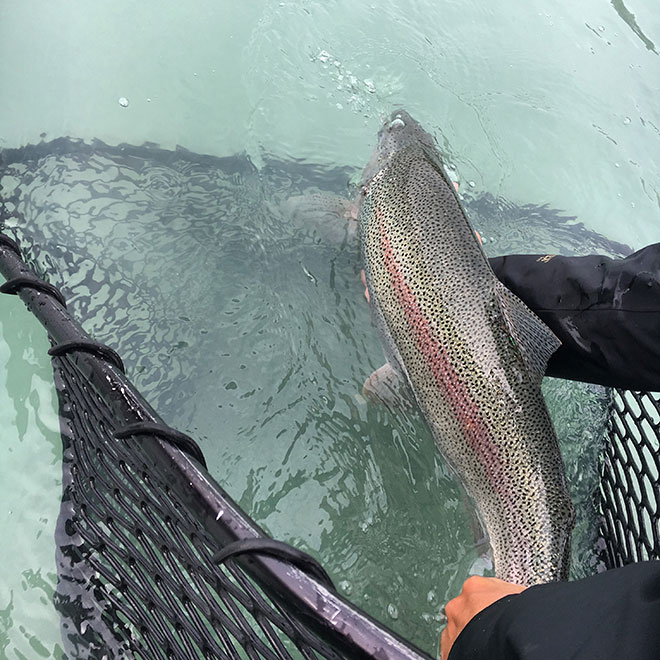The Importance of Proper Handling of a Trophy Trout
By Nigel Fox, Alaska Drift Away Fishing

Reviving a rainbow while measuring length on the measuring board.
If there is one thing we all can do better when trout fishing, it is properly handling our catch before it is released. Everyone is guilty of mishandling trout. Even as a guide, over the years it’s happened to me a time or two. Whether you get excited and drop your fish, hold it out of the water too long or you don’t wet your hands first before picking up the fish, all of these things and more will affect the outcome of the trout’s life. I will go over a few techniques in this article that I have learned over the years guiding and fishing for trophy trout that can hopefully help improve the way we all handle our catch-and-release fish.
First things first, it all starts when you hook a trophy trout. Fighting or playing a trophy trout can take several minutes, especially if it is close to or over that glorious 30-inch mark. Generally, if my clients are fighting a trout for 15 minutes, I will let them know they have 5 minutes left until we will consider breaking off the fish. Over-playing a trout is nearly the same as keeping it out of the water too long. The buildup of lactic acid in the trout from an excessively long battle can kill the fish. Because of this, I generally run a stiffer drag than most so I can wear the fish out fast and bring it to the net sooner.

Girthing a nice rainbow as it rests.
Once your trout is in the net (rubber catch-and-release net), you want to let your fish sit in the net for several minutes in the water so it can recover after the battle. Pulling the trout out of the net right after landing it can shock the fish. I compare it to a human running at a full-on sprint for several minutes and then holding your breath. It’s not good for us; and not good for a fish.
You will know when your trout is revived; it will be upright and active in the net. If you can pull into shore without dragging the fish in the net, it makes it easier for photos and for releasing the trout unharmed. While the fish rests in the net I make sure we get cameras ready and everyone in position.

Nigel Fox and his client with a trophy Kenai rainbow trout.
This next step is crucial in my opinion: taking a picture. I like this step to be fast, handling the fish as little as possible. I never have my clients hold the trout if I can help it. No offense to my clients, but some don’t fish much and letting them hold the fish puts the fish’s welfare at risk if they are not adept at handling fish. The client sits on the gunnel leaning slightly over the water and I have them grab onto the hoop of the net. I am generally in front of them leaning over the gunnel of the boat. I wet my hands, cradle the fish on its belly behind the pectoral fins and grip the “wrist” of the fish in front of the tail. I lift the supported fish over the net (which is still in the water) and just clear of the hoop. This way, if the fish slips out of my hands it will fall back into the net in the water, or back into the river. Either way, it will be safe for the fish, but I prefer it falls into the net. Then I can make sure it recovers fully before it swims off. It is very important to never lift the trout into the boat or out of the water for more than 10 seconds. Best case is to take the picture with the trout in the water and then all of your bases are covered.
MORE: Alaska Drift Away Fishing Articles & Blogs
After we get a photo, I quickly measure length and girth the trout before releasing it back into the river. I use a measuring board for length and a soft measuring tape for girth. All of the measurements are done in or over the water so that if the trout flops it will go back into the water unharmed. I never just drop the trout back into the water, I always make sure they are revived and swim away strong.

Girthing a nice rainbow as it rests.
This technique has been very effective for me as guide on the Kenai River. I only use this procedure for what I consider a trophy trout (24- to 30-plus inches). I generally do not handle trout smaller than 24 inches if possible because they don’t seem as hardy. I see mishandling of fish that are going to be released on a daily basis. We must police ourselves in this area to help ensure the health of the trout population we all love. I hope this article provides you with some simple pointers you can use when handling fish. See you on the river!

Releasing a Kenai trophy rainbow trout.
Nigel Fox has been partners with Jeremy Anderson and Nick Ohlrich at Alaska Drift Away Fishing for close to two decades. He is a lifelong Alaskan and has been fishing on the Kenai River since he was a young boy, and each year he learns more about the intricate world of catching trophy salmon and trout on the Kenai and Kasilof rivers.


